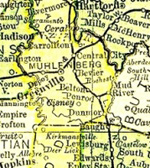Muhlenberg County Kentucky

Local History: S
South Carrollton
Editor's note - The following paper was prepared by O.H. Wallace, Greenville, and read by Frank Hunter before the Kiwanis Club Thursday, March 25, 1937.
The town of South Carrollton was begun about the year 1838, although it was not incorporated until Feb. 25, 1849. It was laid out by John Fentress on what was known as the “Old Randolph Farm” on which a tanyard had been operated for many years.
Being located on Green River, South Carrollton was the shipping point for all produce and minerals to the markets. This point served as large radius due to these marketing facilities.
The Buckner and Churchill furnaces, which used this as a shipping point, were abandoned in 1842, due to the enormous expense of hauling pig iron over the new and rough roads.
The Whitehall and Lovelace taverns were the first and second hotels in South Carrollton and in their day were among the best known places in the county.
South Carrollton was also the scene of some excitement during the Civil War. January 16, 1861, Gen. Thomas R. Crittenden, in command of federal forces, moved his division there, where it remained until Jan. 29, 1862. His headquarters were at the Lovelace Tavern. On two hills south and southwest of South Carrollton, Crittenden threw up breastworks, remains of which can still be seen. In a number of places at the foot of the hills and in the valley between them, he felled wide rows of trees, thus constructed an abatis for the defense of his position. What is now the residence of John L. Taylor was used as a hospital by the 11th Kentucky Infantry, whose camp was located nearby.
In Jan., 1862, Gen. Grant, in his attach against Ft. Henry and Ft. Donaldson, stationed a division at South Carrollton consisting of the 11th and 26th Kentucky Infantry, 3rd Cavalry, the 42nd and 43rd Indiana Infantry, and Beho's artillery, making a total of a little less than 5,000 soldiers.
Gen. Von Stuben, the distinguished Prussian general, located his Virginia military warrants, granted him for his services in the Revolution, in the vicinity of South Carrollton. However, it was all lost (some 4,000 of more acres) to his estate, under the occupying claimant limitation law.
Jake Bennett made his first raid through Muhlenberg County in 1865, captured Joseph and John Chatham at Greenville and made them show him the way to South Carrollton. The march was made safely through that town, into Hopkins and Union counties, where he disbanded a few days before the surrender of General Lee.
One of the best known educators in Western Kentucky, Prof. Wayland Alexander, had charge of a fine college in South Carrollton, known as the South Carrollton Male and Female Institute. In 1886 this institute became known as the West Kentucky Classical and Normal College by an act approved Feb. 23, 1874. This institution brought so many young men and women to South Carrollton that the place seemed destined to become the Athens of the Green River country. Its course of studies was of high order and graduates were given license to teach in any public school in Kentucky without passing an examination before the state board. Many unlimited sholarships were sold at the rate of $300 each, good for an indefinite period and were transferable.
The students who attended this school during its early career received the benefit of all the capital derived from the paid-up scholarship but in the course of a few years all the money devised from the sale of these scholarships was used to pay the teachers' salaries and the scholarships that had been sold became the source of obligations involving expense which the institute had made no provision to meet. Financial aid was occasionally given and the school temporarily survived. This state of its financial affairs, coupled with increasing competition, resulted in the closing of the college.
After the L.&N. Railroad Co. laid its line through South Carrollton, improving the transportation facilities, several new enterprises were undertaken, some of them surviving as long as the beginning of the 20th century.
A rock quarry was opened and operated by John Ohman and at one time employed as many as 100 men. The rock was cut and shipped by rail and boat to Owensboro, Nashville, Memphis, Knoxville and other cities for building purposes. The old depot in Owensboro was build with stone blocks cut at this quarry. Some of the stonecutters employed were paid as high as $8 a day. (We presume this to be a six-hour day; however, it may have been 12 or more.)
The town had a distillery operated by Tom Baker about the year 1888, which burned and was never rebuilt. The name and quality of the product could not be learned. Several cooperages were operated in South Carrollton about this time and a flour mill was built by Humphrey Brothers and sold to Woolcott Brothers, who operated it for 40 years before selling it to J.L. Rogers a few years ago.
With the coming of better roads and more modern transportation, the business life of the town has continued to ebb. It has had two major losses by fire in the last 50 years, the first fire destroying an entire block next to the business section.
The necessity for a jail in South Carrollton has been little; however, they have always had a hold-over for prisoners. A few years ago a negro named Garner Wickliffe was jailed for being drunk and after yelling all day, he began to yell fire. The jailer thought this was only a part of his continued spree and did not investigate at the time. In a few minutes it was found that the place was on fire and the negro burned to death before he could be removed.
Source: Times-Argus [Central City, KY], 26 Apr 1972.
Updated July 14, 2022